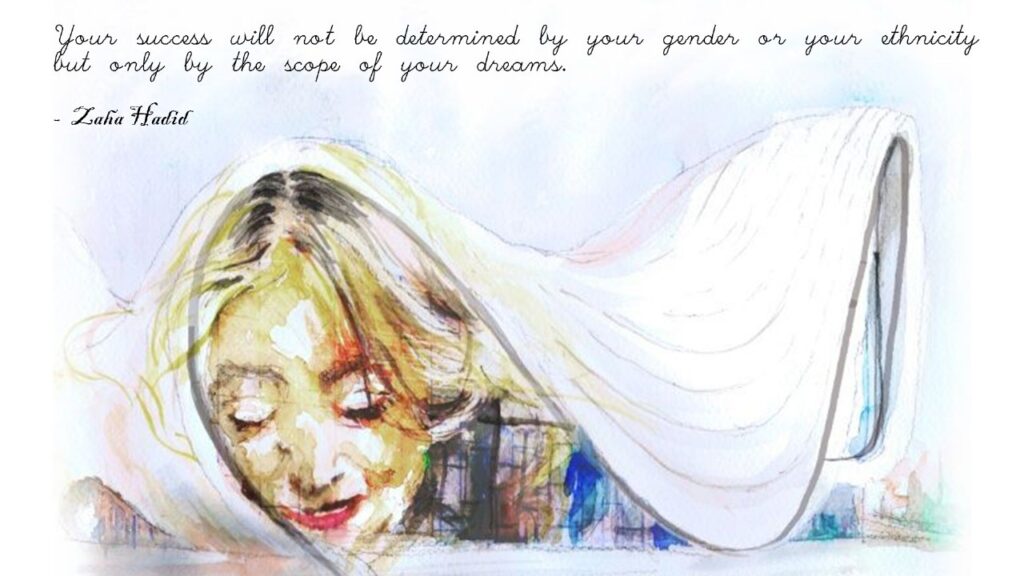~Zaha Hadid In a world where barriers often come disguised as norms, this quote by Zaha Hadid slices through the noise like one of her futuristic designs. It is not just a motivational mantra it is a manifesto. A defiant, empowering, and visionary declaration from one of the most influential architects of our time. For …

~Zaha Hadid
In a world where barriers often come disguised as norms, this quote by Zaha Hadid slices through the noise like one of her futuristic designs. It is not just a motivational mantra it is a manifesto. A defiant, empowering, and visionary declaration from one of the most influential architects of our time. For architects, creatives, and dreamers across the globe especially those who have been historically sidelined these words serve as both a challenge and a call to rise.
From an architect’s lens, this quote becomes deeply personal. Architecture is a field that demands technical excellence, aesthetic sensitivity, spatial intelligence, and an unrelenting drive. Yet, it is also a profession that, for centuries, has mirrored societal hierarchies where success has too often been gated by gender, race, or class. Hadid’s words uttered not from the comfort of privilege, but from the trenches of discrimination ring even louder.
The Unapologetic Dreamer: Zaha Hadid’s Own Blueprint
To fully appreciate this quote, one must trace the trajectory of the woman who said it. Zaha Hadid was not merely the first woman to win the Pritzker Prize in 2004 she was a radical, a visionary, and often, an outsider.
Born in Baghdad in 1950, Zaha was raised in a progressive, intellectual family that emphasized education and ambition. But her journey from the Middle East to becoming the “Queen of the Curve” was not smooth. As a woman, an Arab, and a conceptualist in a Eurocentric and male-dominated profession, she was told repeatedly that she was too bold, too difficult, too imaginative.
And yet, she refused to shrink her dreams.
When critics doubted her gravity-defying forms, she stayed the course. When projects were deemed “unbuildable,” she pushed the limits of engineering. When the industry expected conformity, she gave them geometry.
Her quote, then, is not naive idealism. It’s a rebuke of those who dared to limit her, and a torch passed to the next generation.
Deconstructing the Quote
Let’s take a closer look at the layers of meaning within this deceptively simple quote.
“Your success will not be determined by your gender or your ethnicity…”
These opening words acknowledge, rather than ignore, the systemic prejudices that exist. Hadid isn’t saying these factors don’t matter in society they obviously do. She faced them. We all do.
But she is flipping the narrative. She’s declaring that while these attributes may affect how others perceive you, they do not define your potential. They are not your ceiling. They are not the borders of your capability.
For any architect especially one breaking new ground this is vital. Because if your identity becomes a limitation in your mind, then you begin to design small. To aim low. To self-censor.
Zaha’s philosophy: do not let the world’s bias dictate the size of your dreams.
“…but only by the scope of your dreams.”
Here lies the core of her message. Success, she says, is not a function of where you come from it’s a function of how big you dare to dream.
In architecture, dreaming big doesn’t just mean tall skyscrapers. It means bold ideas. Challenging norms. Designing not for today, but for what could be tomorrow. It means envisioning cities that are sustainable, spaces that are inclusive, and forms that redefine human experience.
Hadid’s own buildings embody this kind of dreaming. They twist, hover, undulate, and explode conventions. They don’t apologize for their drama they celebrate it. In doing so, they remind architects that dreaming is not optional it is the job.
And the scope of your dream? That’s your design brief for life.
Architecture as a Stage for Ambition
Architecture is not an easy field to dream in. It’s deeply entangled with budgets, bylaws, site constraints, client demands, and cultural conservatism. It requires immense perseverance just to stay in the game let alone to innovate within it.
This is precisely why Hadid’s quote matters.
She is urging architects especially the marginalized to see beyond gatekeepers and glass ceilings. To believe that architecture needs their voice, their identity, their expression.
Because the world doesn’t just need more buildings it needs diverse visions of the future.
Let’s explore how dreaming big, in the Zaha sense, translates into architectural practice.
1. Breaking the Bias Blueprint
Historically, architecture has excluded many especially women and people of color. Representation in leadership roles, jury panels, awards, and curriculum content has been dismally skewed.
To dream big in this context is a form of resistance. It means entering the studio, the site, the boardroom, with the conviction that you belong. It means pushing for visibility not just for oneself, but for others.
Zaha shattered the archetype of what a “great architect” looks like. She didn’t become the token; she became the titan.
2. Designing with Identity, Not Despite It
Ethnicity and gender are not just socio-political facts they’re reservoirs of richness. Culture influences how we perceive space, light, privacy, material, and rhythm.
Hadid’s background her Iraqi roots, her Western education, her global career merged into a unique design language that had both regional depth and cosmic ambition.
For architects from underrepresented communities, this is key: your identity is not baggage; it is your blueprint. Designing with authenticity creates architecture that resonates on deeper levels.
3. Radical Forms, Radical Futures
Hadid’s work challenged architectural formalism. Her buildings appeared as if they were moving, melting, or levitating. But behind their flamboyance was a deep structure mathematics, parametrics, tectonics.
This marriage of dream and discipline is a lesson to architects: dreaming big doesn’t mean abandoning rigour it means expanding it. It means developing the tools and teams to make the impossible plausible.
Whether it’s a cultural center that resembles a spacecraft or a stadium that mimics a desert bloom these are forms of dreaming that shape the future’s aesthetic, spatial, and emotional terrain.
4. Mentorship and Legacy
Hadid’s firm became a launchpad for young, diverse talent. She didn’t hoard opportunity she opened doors. In doing so, she embodied the very spirit of this quote: she showed that dreaming big is contagious.
As architects, we must consider: Are we passing the torch? Are we nurturing others to dream beyond their conditioning?
Because dreaming is generational architecture what you build in others outlasts your own portfolio.
5. Resilience in Rejection
Before she built anything, Hadid was already considered a genius by theorists. But for years, her designs remained paper architecture too radical to realize. Projects were rejected, delayed, shelved.
Yet she persisted.
Dreaming big often means facing more rejection. But those who stop at rejection never get to the realization stage. Architects must develop not only creativity but courage. The world rarely applauds pioneers until the dust settles.
Hadid’s career is proof: the longer the runway, the higher the flight.
Rewriting the Rules of Success
What is success in architecture? Is it awards, square footage, LEED ratings, billable hours?
Zaha Hadid reframed success as vision manifest. To her, success wasn’t just having a thriving practice it was reshaping what architecture could be.
As young architects, students, or mid-career professionals, the scope of your dreams may differ. You may dream of building a home for your parents, revitalizing a village, starting a firm, or winning the Pritzker. The point is not the size it’s the sincerity.
Dreams that come from truth rooted in service, innovation, and soul are the ones that build lasting architecture.
Architecture Beyond Borders
Zaha Hadid’s quote is not just about architecture it’s about agency. It says: You are not limited by what you were born into. You are empowered by what you dream toward.
For architects, this is liberation. We are trained to respond to constraints site lines, codes, loads. But the greatest constraint is often internal: the belief that certain dreams aren’t “for people like me.”
Hadid destroys that myth.
She reminds us that architecture is not neutral. It is personal, political, powerful. And those who have been historically silenced must now sketch louder, build bolder, and dream wider.
So, dream in curves. Dream in contradictions. Dream in your language, your scale, your style.
And never forget: the measure of your success will not be the limits others placed on you but the limits you dared to exceed.






